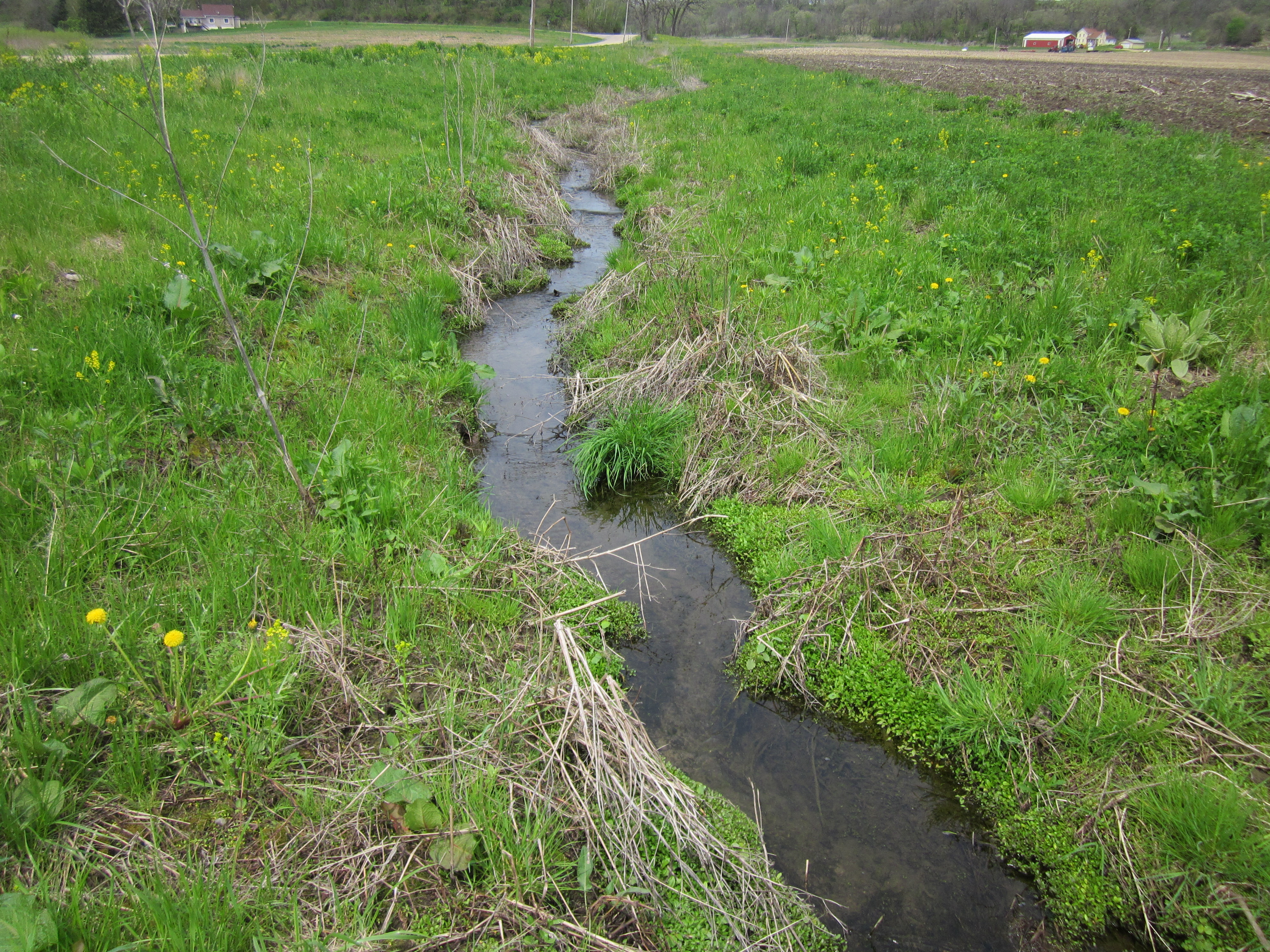
2 Miles
0 - 2
Cool-Cold Headwater, Coldwater
2017
Good
Green
No
No
No
Fish and Aquatic Life
Overview
Krieg Valley Creek is a small high gradient stream that flows into Pioneer Valley Creek northwest of New Glarus. The fishery is restricted to forage species. It has not been monitored recently.
Date 2002
Author Aquatic Biologist
Historical Description
Bush, D.M., R. Cornelius, D. Engle, and C.L. Brynildson. 1980. Lake and Stream Classification Project. Surface Water Resources of Green County, 2nd Edition. Wisconsin Department of Natural Resources, Madison, Wisconsin.This small sprinq fed stream drains a narrow steep sided valley in the driftless area. flows east and enters Pioneer Valley Creek northwest of New Glarus. A high gradient maintains a gravel-rubble or hardpan bottom. Watercress is abundant and supports an excellent population of aquatic insects. The stream is rarely inter- mittent but frequently freezes out in the winter time. The water is generally turbid. In the upper half of the watershed the stream meanders through pasture with relatively low. grass covered banks. The lower end of the stream flows through cropland and has been ditched. Its steep. four foot banks are covered with a narrow band of trees and shrubs.
The fishery is restricted to forage species and only white suckers and creek chubs were collected during a
1974 fish management survey. Five acres of adjoining wetland provides a minimal wildlife habitat in which a small muskrat population reside. Public access is provided at one road crossing and along one-quarter mile of town road bordering the stream.
Fish Species: White sucker, creek chub.
Surface Acres= 0.7, Length= 1.9 Miles, Gradient= 68 ft./mi., Base Discharge= 0.4 cu. ft./sec.
Date 1980
Author Surface Water Inventory Of Wisconsin
Condition
Wisconsin has over 84,000 miles of streams, 15,000 lakes and milllions of acres of wetlands. Assessing the condition of this vast amount of water is challenging. The state's water monitoring program uses a media-based, cross-program approach to analyze water condition. An updated monitoring strategy (2015-2020) is now available. Compliance with Clean Water Act fishable, swimmable standards are located in the Executive Summary of Water Condition in 2018. See also the 'monitoring and projects' tab.
Reports
Management Goals
Wisconsin's Water Quality Standards provide qualitative and quantitative goals for waters that are protective of Fishable, Swimmable conditions [Learn more]. Waters that do not meet water quality standards are considered impaired and restoration actions are planned and carried out until the water is once again fishable and swimmable
Management goals can include creation or implementation of a Total Maximum Daily Load analysis, a Nine Key Element Plan, or other restoration work, education and outreach and more. If specific recommendations exist for this water, they will be displayed below online.
Monitoring
Monitoring the condition of a river, stream, or lake includes gathering physical, chemical, biological, and habitat data. Comprehensive studies often gather all these parameters in great detail, while lighter assessment events will involve sampling physical, chemical and biological data such as macroinvertebrates. Aquatic macroinvertebrates and fish communities integrate watershed or catchment condition, providing great insight into overall ecosystem health. Chemical and habitat parameters tell researchers more about human induced problems including contaminated runoff, point source dischargers, or habitat issues that foster or limit the potential of aquatic communities to thrive in a given area. Wisconsin's Water Monitoring Strategy was recenty updated.
Grants and Management Projects
| Project Name (Click for Details) | Year Started |
|---|
|
|
Monitoring Projects
| WBIC | Official Waterbody Name | Station ID | Station Name | Earliest Fieldwork Date | Latest Fieldwork Date | View Station | View Data |
|---|
| 883200 | Krieg Valley Creek | 10037458 | Krieg Valley Creek approx. 65 meters upstrm from confluence with Pioneer Valley Crk | 6/14/2017 | 10/4/2017 | Map | Data |
|

Watershed Characteristics
Krieg Valley Creek is located in the Little Sugar River watershed which is 133.02 mi². Land use in the watershed is primarily agricultural (46.80%), grassland (32.10%) and a mix of forest (13.90%) and other uses (7.00%). This watershed has 351.74 stream miles, 50.40 lake acres and 3,252.10 wetland acres.
Nonpoint Source Characteristics
This watershed is ranked Not Ranked for runoff impacts on streams, Not Ranked for runoff impacts on lakes and High for runoff impacts on groundwater and therefore has an overall rank of High. This value can be used in ranking the watershed or individual waterbodies for grant funding under state and county programs.However, all waters are affected by diffuse pollutant sources regardless of initial water quality. Applications for specific runoff projects under state or county grant programs may be pursued. For more information, go to surface water program grants.
Krieg Valley Creek is considered a Cool-Cold Headwater, Coldwater under the state's Natural Community Determinations.
Natural communities (stream and lake natural communities) represent model results and DNR staff valiation processes that confirm or update predicted conditions based on flow and temperature modeling from historic and current landscape features and related variables. Predicated flow and temperatures for waters are associated predicated fish assemblages (communities). Biologists evaluate the model results against current survey data to determine if the modeled results are corect and whether biological indicators show water quaity degradation. This analysis is a core component of the state's resource management framework. Wisconsin's Riverine Natural Communities.
Cool (Cold-Transition) Headwaters are small, usually perennial streams with cold to cool summer temperatures. Coldwater fishes are common to uncommon (<10 per 100 m), transitional fishes are abundant to common, and warm water fishes are uncommon to absent. Headwater species are abundant to common, mainstem species are common to absent, and river species are absent.